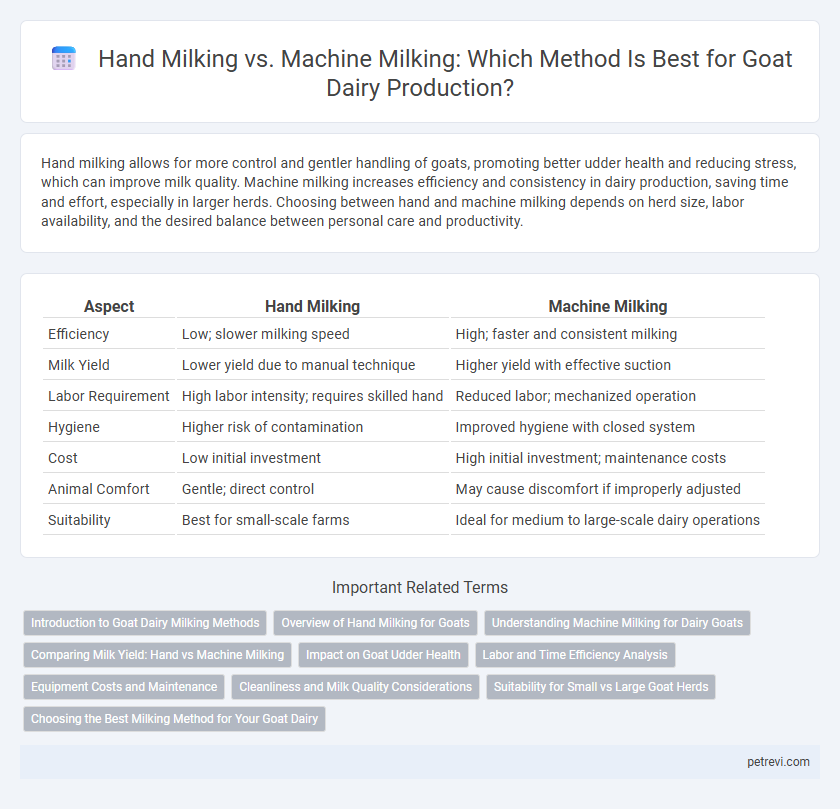Hand milking allows for more control and gentler handling of goats, promoting better udder health and reducing stress, which can improve milk quality. Machine milking increases efficiency and consistency in dairy production, saving time and effort, especially in larger herds. Choosing between hand and machine milking depends on herd size, labor availability, and the desired balance between personal care and productivity.
Table of Comparison
| Aspect | Hand Milking | Machine Milking |
|---|---|---|
| Efficiency | Low; slower milking speed | High; faster and consistent milking |
| Milk Yield | Lower yield due to manual technique | Higher yield with effective suction |
| Labor Requirement | High labor intensity; requires skilled hand | Reduced labor; mechanized operation |
| Hygiene | Higher risk of contamination | Improved hygiene with closed system |
| Cost | Low initial investment | High initial investment; maintenance costs |
| Animal Comfort | Gentle; direct control | May cause discomfort if improperly adjusted |
| Suitability | Best for small-scale farms | Ideal for medium to large-scale dairy operations |
Introduction to Goat Dairy Milking Methods
Hand milking remains a traditional method in goat dairy production, offering greater control over the milking process and ensuring gentle handling of goats. Machine milking enhances efficiency and consistency, especially in larger dairy operations, utilizing vacuum systems to extract milk rapidly. Both methods require proper hygiene and equipment maintenance to maintain milk quality and animal health.
Overview of Hand Milking for Goats
Hand milking for goats involves manually extracting milk, offering greater control over the milking process and minimizing stress for the animal. This traditional method requires skill and patience, ensuring gentle handling that promotes udder health and milk quality. Hand milking is especially favored in small-scale or organic goat dairy production where personalized care and natural practices are prioritized.
Understanding Machine Milking for Dairy Goats
Machine milking for dairy goats enhances efficiency by using pulsation systems that mimic natural suckling, ensuring consistent milk flow while reducing stress on the animals. Automated milking machines include teat cups, vacuum pumps, and liners designed to maintain udder health and hygiene, minimizing contamination risks. This method supports higher milk yields and improved dairy farm productivity compared to traditional hand milking techniques.
Comparing Milk Yield: Hand vs Machine Milking
Machine milking in goat dairy production typically yields higher milk volumes per session due to consistent suction and reduced milking time, often increasing efficiency by 20-30% compared to hand milking. Hand milking allows for gentle handling and can minimize stress in smaller herds, but it usually produces lower milk output and is labor-intensive. Research indicates that automated milking systems optimize milk extraction and quality, making machine milking preferable for commercial-scale operations seeking maximum milk yield.
Impact on Goat Udder Health
Hand milking in goat dairy production typically results in gentler handling, reducing stress and lowering the risk of teat injuries, which promotes better udder health. In contrast, machine milking, if improperly adjusted or maintained, can cause teat-end damage and increase the incidence of mastitis, negatively affecting milk quality and animal welfare. Proper technique and regular equipment inspection are essential to minimize adverse effects and maintain optimal udder condition in both milking methods.
Labor and Time Efficiency Analysis
Hand milking goats requires significant manual labor and can take approximately 10-15 minutes per goat, making it less efficient for large-scale dairy operations. Machine milking systems reduce labor intensity and time, often milking multiple goats simultaneously in under 5 minutes each, increasing overall productivity. Investing in automated milking infrastructure optimizes labor resources and supports higher volume dairy production with consistent milking schedules.
Equipment Costs and Maintenance
Hand milking requires minimal upfront investment, primarily consisting of basic milking stools and buckets, making it ideal for small-scale goat dairy operations. Machine milking involves higher equipment costs, including milking machines, vacuum pumps, and pipelines, leading to increased initial capital expenditure but greater efficiency for larger herds. Maintenance expenses for machine milking systems include regular cleaning, lubrication, and periodic replacement of vacuum seals and rubber liners, which can add to operational costs compared to the low maintenance needs of hand milking.
Cleanliness and Milk Quality Considerations
Hand milking goats allows for precise control over cleanliness by enabling individual udder inspection, reducing contamination risks and ensuring higher milk quality. Machine milking systems can process large herds efficiently but require rigorous sanitation protocols to prevent bacterial buildup that can degrade milk purity. Optimal milk quality in goat dairies depends on maintaining strict hygiene standards regardless of milking method, with hand milking often favored for small-scale operations prioritizing cleanliness.
Suitability for Small vs Large Goat Herds
Hand milking is highly suitable for small goat herds due to its low cost and minimal equipment requirements, allowing farmers to maintain close animal contact and control milk quality. Machine milking is more efficient for large herds, as it significantly reduces labor time and increases milk output while ensuring consistent milking practices. For dairy producers managing herds exceeding 50 goats, investing in automated milking systems optimizes production scalability and hygiene standards.
Choosing the Best Milking Method for Your Goat Dairy
Hand milking offers precise control and gentle handling, ideal for small-scale goat dairies prioritizing animal comfort and traditional methods. Machine milking enhances efficiency and consistency, suitable for larger operations aiming to increase production volume while maintaining hygiene standards. Selecting the best milking method depends on factors like herd size, labor availability, and desired milk yield quality in goat dairy production.
Hand Milking vs Machine Milking for Goat Dairy Production Infographic

 petrevi.com
petrevi.com